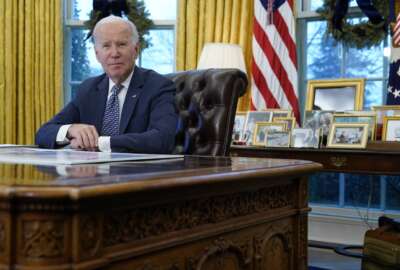
How does locality pay actually work, and where did it come from?
Explaining the history of locality pay and how it affects federal employees on the General Schedule.
Most civilian federal employees will see a slightly higher number on their paychecks in 2023, but exactly how much more largely depends on where they work.
That’s because in most years, the government breaks down the federal pay raise between a base pay raise and a locality pay raise.
The base pay raise is the amount that all federal employees on the General Schedule will get, regardless of where they work. For 2023, the base pay raise is 4.1%.
The locality pay raise is more complicated. On top of the 4.1% that everyone gets in 2023, there’s an additional 0.5% bump, totaling to a 4.6% federal pay raise overall. But the locality portion of that percentage is an average. Some federal employees might see a slightly lower percentage raise, while others might see a slightly higher one.
It all depends on where a federal employee is located. The federal government currently defines 54 different locality pay areas, each with its own independently calculated percentage-based pay raise for civilian federal employees.
How locality pay started
The federal government established locality pay in 1990, as part of the Federal Employees Pay Comparability Act (FEPCA). FEPCA was initially meant to counter the growing wage gap between the federal and non-federal job sectors.
According to the Federal Salary Council, a council composed of federal pay experts, the overall average wage gap in 2022 between federal and non-federal occupations was 24.09%.
FEPCA authorizes the funding necessary to reduce the wage gap between federal and non-federal pay down to 5%, but since 1994, no presidential administration of either party has fully adopted FEPCA.
Instead, presidents typically issue what’s called an “alternative pay plan,” which enacts a federal pay raise that’s lower than the gap that the Federal Salary Council calculates. President Joe Biden proposed a 4.6% federal pay raise for 2023, and that plan took effect after Congress declined to take its own action on 2023 pay.
After nearly 30 years of presidents issuing alternative pay plans, the estimated cost to reduce the federal versus non-federal pay disparity down to 5% has grown to approximately $19.2 billion. That cost is a “significant consideration,” according to the latest report from the president’s pay agent, a three-person panel composed of the Labor Department secretary, Office of Management and Budget director and Office of Personnel Management director.
How locality pay works
A common misconception is that the government sets locality pay by comparing local living costs, but that’s not actually the case. Instead, locality pay is calculated by comparing wages for federal versus non-federal employees in similar occupations, who live in the same geographic region.
That information comes from the Bureau of Labor Statistics (BLS). The bureau uses the National Compensation Survey (NCS) to measure wage disparities.
BLS can measure, for instance, the difference in wages between an engineer working for a private company, versus an engineer working for a federal agency, in the same city.
The difference in wages, or the pay gap, between the two comparable positions helps determine what the locality pay adjustment should be for a given area.
Some economists and think tanks, however, argue that the pay gap is misrepresentative, because it doesn’t account for the value of benefits, and only relies on wages to make the calculation. Many have said that by considering the added value of benefits, federal employees are actually paid more than non-federal employees.
The president’s pay agent also said that the underlying methodology for calculating locality pay “has lacked credibility since the beginning,” and that’s part of the reason presidential administrations continue to override FEPCA.
“The current pay comparison methodology used in the locality pay program ignores the fact that non-federal pay in a local labor market may be very different between different occupational groups,” the pay agent said. “As currently applied, locality payments in a local labor market may leave some mission-critical occupations significantly underpaid while overpaying others.”
How to calculate your actual raise using locality pay
The alternative pay plan institutes a 4.6% raise for 2023, but again, that percentage is an average. Having different locality pay areas means that some feds will see a little more or less, depending on which locality area they’re part of. Taking into account all the different locality pay areas, the actual raises for 2023 range from 4.35% to 5.15%.
Federal News Network compiled a table for all GS employees to see what their 2023 pay raise will be.
But it’s important to look at how exactly you get to that end percentage.
To calculate your actual pay raise, first add the base pay percentage, followed by the locality pay percentage. The steps below explain how to do that:
- Multiply your current base salary by this year’s base pay raise percentage
- Add the result from step 1 to your current base salary
- Multiply the result from step 2 by this year’s locality pay raise percentage for your locality pay area
- Add the result from step 3 to your answer from step 2 (rounding up)
Here’s an example. Let’s say a federal employee who is GS-7, step 1, lives in the Washington, D.C. area. In 2022, their base salary was $38,503. The employee is in the Washington-Baltimore-Arlington, DC-MD-VA-WV-PA locality pay area, which for 2023 means their locality pay increase is 32.49%. What is their salary in 2023?
- Multiply $38,503 by 0.041, to get $1,579
- Add $1,579 to $38,503, to get $40,082
- Multiply $40,082 by 0.3249, to get $13,023
- Add $13,023 to $40,082, to get $53,105
The employee’s actual salary for 2023 is $53,105.
If you don’t want to do the math, the Office of Personnel Management offers a simple GS salary calculator on its website. The agency also has a chart compiling base pay for 2022, as well as one for base pay for 2023.
Who gets locality pay?
Most federal employees on the General Schedule receive locality pay each year, which is determined by their physical location.
Currently, there are 53 distinct locality pay areas, plus a 54th “Rest of U.S.” category that encompasses any GS employees not living in one of those 53 regions.
The president’s pay agent just approved the addition of four new locality pay areas: Fresno, California; Reno, Nevada; Rochester, New York; and Spokane, Washington.
Additionally, the pay agent expanded the Richmond, Virginia, Boston, Detroit and Seattle locality pay areas to include more surrounding counties.
But none of those changes will go into effect until 2024 at the earliest. A presidential administration first has to publish regulations on the new localities before they become official.
And not everyone working for the federal government receives a locality pay raise. Here’s a list of who doesn’t receive locality pay:
- Employees paid under the senior level, scientific and professional pay systems
- Members of the Senior Executive Service
- Employees paid under critical pay authority
- Senior executives in temporary organizations
- Prevailing rate employees
- Executive Schedule employees
- Any position that has basic pay higher than the Executive Schedule level 4
Copyright © 2024 Federal News Network. All rights reserved. This website is not intended for users located within the European Economic Area.
Drew Friedman is a workforce, pay and benefits reporter for Federal News Network.
Follow @dfriedmanWFED





